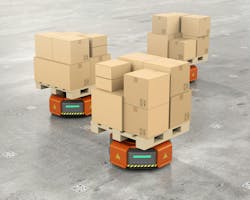Critical Metrics to Maximize AMR ROI
Key Highlights
- Outdated box suites and poor dimensional data plague warehouse operations. One company hadn't updated its packaging in 20 years, crippling efficiency until optimization delivered three-month AMR payback.
- Establishing accurate dimensional data during initial AMR deployment is ideal, but existing operations can still unlock significant gains through packaging optimization and workflow simulations.
- Tracking metrics like picking accuracy, order pick rate, travel distance per pick, inventory accuracy and warehouse space utilization helps operations identify bottlenecks and optimize labor allocation for maximum throughput.
Autonomous mobile robots (AMRs) have become fairly ubiquitous in warehouses, with hundreds of vendors now offering AMRs that promise increased throughput and reduced labor costs. While these systems generally deliver on their promises, there's a hidden challenge that often prevents AMR operations from achieving their projected returns.
"I'm going to argue that a surprising number of times these AMR deployments, while they may help significantly, it is the exception when they perfectly capture the business case that was developed for their deployment initially," said James Malley, co-founder and CEO of Paccurate, a packaging optimization software company, during a presentation at Pack Expo 2025.
The ROI reality check
A common source of disappointment with AMRs are stretched payback periods that leave ROI tantalizingly close but not quite meeting initial projections. The culprit? It's usually a single variable: orders per cart, said Malley.
"This can be the single most impactful variable that goes into a business case, and it's more often than not, the reason why something might not go the way you want with AMRs," he explained.
The mathematics behind AMR adoption here are compelling. A 10-15% increase in order lines per robot can yield a 30-50% uplift in overall system ROI, said Malley. This non-linear relationship makes optimization efforts particularly valuable for AMR users.
Malley noted that, before this kind of optimization can begin to deliver such returns, operations need to rely on accurate dimensional data. Fortunately, collecting this information has become much easier in recent years, “with handheld devices enabling teams to quickly dimensionalize inventory,” he said.
Maximizing orders per cart through proper data management and packaging optimization can transform good AMR performance into exceptional ROI.
Such tools are key, according to Mallet, because "nobody can trust the data they get from the supplier." This is why he said the onus is on shippers to establish processes for collecting accurate measurements to ensure such instances as "your system says the lipstick is four feet long and it's really only four inches long" are not commonplace.
He added that numerous consultants can help establish proper data collection systems if you don’t have available internal resources to do this effectively.
Desperation-driven innovation
To illustrate his point on the importance of reliable data, Malley shared the story of a retailer facing a potential business-ending crisis when their parcel carrier changed rates in a way that impacted their shipments. This prompted a comprehensive review of the business’s operations, leading them back to their AMR vendor partner to seek answers.
The vendor initially approached the problem with a simple spreadsheet, examining variables like aisle distances. But the real breakthrough came when they identified cartonization efficiency as the hidden issue.
The retailer discovered their stock box suite hadn't been updated in 20 years — a common situation in many packaging and shipping operations. "We have this box and we don't know what it's for, but Dave, who retired, ordered it and we're afraid to get rid of it," Malley quipped as he described a scenario familiar to many packaging operations.
The mathematics behind AMR adoption here are compelling. A 10-15% increase in order lines per robot can yield a 30-50% uplift in overall system ROI.
By implementing a packaging control system to optimize their box suite along with deployment of SKU-specific packaging rules, the retailer found that it only need to add one more box per shelf with their new configuration to address the rate change and boost ROI.
The results were dramatic: a three-month ROI on their AMRs, an 11% improvement in lines per hour, and fewer pallets and truckloads needed per month, delivering immediate transportation savings and margin recovery.
Timing is everything for optimal AMR ROI
"The best time to do this AMR setup with dimensional data is when you first start working with them," Malley advised.
For operations considering AMR deployment, particularly those using box-first workflows, establishing proper dimensional data and optimization capabilities upfront is critical. However, existing operations shouldn't assume they've missed their window.
"If you have AMRs already in a pick and pack operation, you can still figure out if there's any juice to squeeze here without even bothering your vendor," Malley said. To do this, he recommended running simulations or revisiting original business cases to identify opportunities.
Many AMR vendors now take a more holistic approach to business case development, encouraging customers to consult with downstream operations at pack stations to avoid surprises later, Malley added. While some vendors offer in-house tools or preferred partners for packaging optimization.
The key takeaway here, according to Malley is to not let your AMRs sit idle. Maximizing orders per cart through proper data management and packaging optimization can transform good AMR performance into exceptional ROI.
For more insights on picking KPIs to boost productivity, see the sidebar to this article below the more warehouse automation insights links.
More warehouse automation insights from Automation World:
Five Picking KPIs to Boost Productivity
Element Logic, a supplier of warehouse technology and AutoStore distributor offers these key performance indicators to improve warehousing/shipping performance.
1. Picking accuracy measures the precision with which customer orders are picked in the warehouse. Accurate order picking influences fulfillment times, customer satisfaction and reorder frequency. Minimizing picking errors fosters stronger customer relationships and saves time and resources associated with returns. An ASRS (automated storage and retrieval system) uses a grid-based storage system where products are stored in vertically stacked bins and automatically retrieved by intelligent robots, ensuring the correct product is picked from the designated location each time.
2. Order pick rate (also called picks-per-hour) helps predict the number of customer orders that can be fulfilled within a specific timeframe. Similarly, lines per hour (LPH) measures the number of individual product lines or SKUs picked within an hour. These metrics are valuable tools for evaluating employee productivity, facilitating efficient labor allocation, identifying training needs and improving overall workflow efficiency. ASRS mobile robots can operate simultaneously within the grid, allowing for parallel order processing and significantly improving the order pick rate.
3. Travel distance per pick assesses the efficiency of picking routes. An inefficient pick path leads to wasted time and energy. Calculate this metric by dividing the total travel distance by the total number of picks to identify opportunities for minimizing unnecessary travel and reducing equipment wear and tear.
4. Inventory accuracy is the percentage of accurately recorded inventory items compared to actual physical inventory. When you manage inventory accurately, you'll have a much better understanding of how much product you need on hand to meet customer demand.
5. Warehouse space utilization metrics help enhance productivity and reduce operational costs. Efficient storage layouts minimize travel distances, reducing idle time and enabling faster retrieval of items, ultimately enhancing overall order processing speed and boosting other picking metrics like order pick rate.


